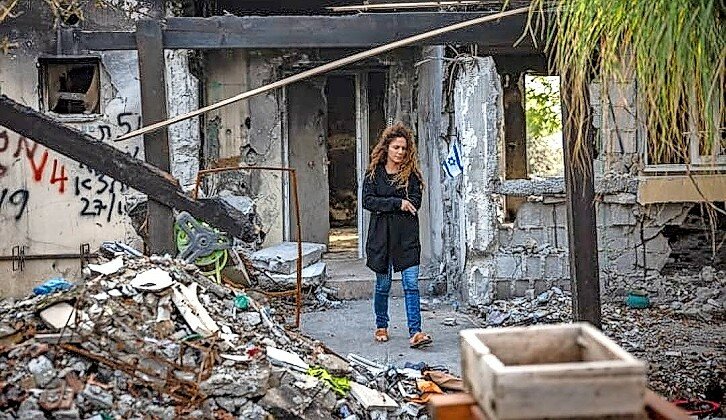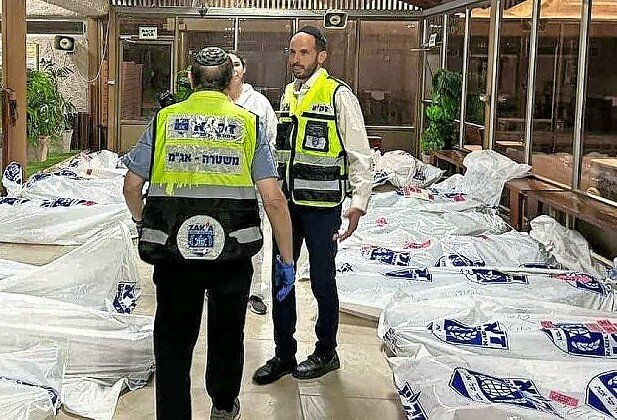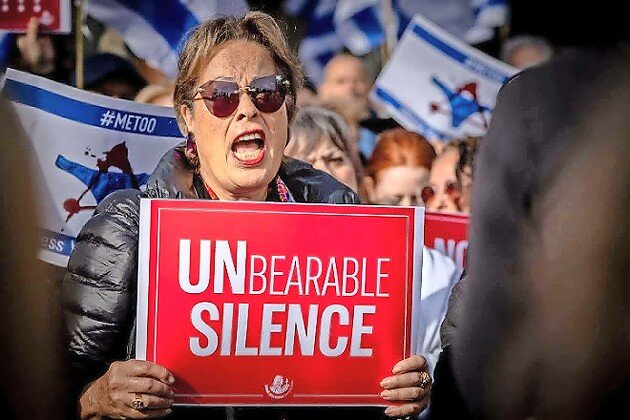Believe all women … unless they’re Israeli victims of the savagery on and after Oct. 7
Editor’s note: This article discusses atrocities committed by Hamas during and after its invasion of Israel and includes sensitive and disturbing content. Discretion is advised in making this accessible to children.
“It’s very sad for me that people would not believe, or deny, the sexual violence perpetrated by Hamas,” a former Israeli hostage told JNS. “I was with the girls in Gaza that were abused and while it’s very difficult to discuss in detail, I saw them after it happened. The girls would not stop talking about their period and I am very worried about them.”
The woman, in her 60s, was freed from Hamas captivity in Gaza in November as part of a ceasefire deal. She asked that her name not be used due to her close connection to another abductee still being held in the Strip.
“I saw that something happened to her. I saw it on her face,” said the ex-captive. “She was very scared. And she did not tell us at the beginning. She was very quiet. After a couple of hours, she told us that he had touched her in all parts of her body.”
This account is one of many excluded from Catherine Philp’s and Gabrielle Weiniger’s June 7 article in the Times of London, titled “Israel says Hamas weaponised rape. Does the evidence add up?”
The piece is a classic example of denialism, cherry-picking information to paint Jews, and by extension their country, as unable to differentiate between reality and fiction due to their political proclivities and past traumas.
Professor Ruth Halperin-Kaddari, Orit Sulitzeanu and Dr. Sarai Aharoni, all of whom were quoted in the London Times piece, released a statement accusing its authors of misrepresentation in service of an agenda.
Despite the article’s claims, “The use of sexual violence as a weapon of war was a significant part of the October 7 attack,” the professors state.
• • •
Halperin-Kaddari, founding director of the Rackman Center for the Advancement of the Status of Women at Bar-Ilan University Law Faculty, told JNS that “sexual violence on October 7 was used as a weapon of war.”
This conclusion is based on “evidence that sexual violence was perpetrated in several distinct locations, all at the same time during a very short span, and all performed with an extremely high degree of brutality,” she said, adding: “We have the footage, the pictures taken at the scene, the testimonies of eyewitnesses and those of first responders who found all the bodies.”
The documented incidents followed a similar pattern and were carried out in a similar fashion, suggesting “it was a premeditated part of the plan of the attack of October 7,” she said.
In March, Amit Soussana, who was freed along with more than 100 others from Hamas captivity as part of the November ceasefire deal. Told the New York Times that she was sexually assaulted during her 54 days of Hamas captivity in the Gaza Strip. She described being held in a children’s bedroom, chained by her ankle, and being violated on multiple occasions by a guard named Muhammad who forced her to “commit a sexual act on him” at gunpoint.
Last week, Soussana recounted her experience during a White House event marking International Day for the Elimination of Sexual Violence in Conflict.
“The sexual assault I experienced should never happen to any human being under any circumstances. No one should ever be sexually violated, and there are no justifying circumstances for these crimes,” she said.
Vice President Kamala Harris vowed not to remain silent after hearing Soussana’s story, saying the Israeli survivor, an attorney, “has bravely come forward with her account of sexual violence while she was held captive by Hamas.”
“These testimonies, I fear, will only increase as more hostages are released,” said the vice president. “We cannot look away. And we will not be silent.”
Harris said that after Hamas’s Oct. 7 massacre in Israel’s northwestern Negev, she witnessed “images of bloody Israeli women abducted.”
Yet in their London Times piece, Philp and Weiniger suggest that “the only reason” Soussana and others “told their story was because they wanted some kind of political pressure on the Israeli government to work harder to release the hostages.”
• • •
Shelly Tal Meron, an Israeli lawmaker from the opposition Yesh Atid Party, confirmed to JNS that “on Oct. 7, we had a lot of cases of sexual assault, mutilation, rape and different kinds of abuse. We also know that it’s happening right now in Gaza so to hear that people are even doubting it is outrageous.”
Tal Meron went on to say, “I have been in contact with hostages who returned from captivity and told me what happened to them. I also met a survivor of the Supernova music festival who heard other women being raped around her. We heard testimony from someone else at the festival who watched a gang rape happen during which the terrorists cut out the breast of their victim and played with it. Another victim was stabbed while being raped and then shot in the back of the head.
“There are a lot of bodies that had sharp objects in the women’s groin, they shot or cut off their intimate parts. We saw that this was a systematic way of Hamas terrorists harming these women.”
Tal Meron is chair of the Global Women’s Coalition Against Gender Based Violence as a Weapon of War and has been speaking in parliaments around Europe.
“Right now, it’s happening in Israel to Jewish women but this is at the doorstep of every country in the world, we have instances in Ukraine, against Yazidi women in Iraq, and in Africa,” she explained.
• • •
After attempting to portray Soussana as a political tool, the London Times authors then attribute fantasies of rape on Oct. 7 to “historical memories” imprinted on the Jewish psyche during centuries of pogroms in Eastern Europe — “a fact that would come to play a role in the reporting of what happened” during the Hamas massacre.
According to Philp and Weiniger, this mental problem is compounded because Jews harbor an “idea of the Arab male as an explicit sexual threat to Jewish women” which, to hammer home their prior point, was “developed in tandem with the movement of Israeli politics to the right.”
The groundwork is thus laid to discredit Zaka, an organization made up primarily of ultra-Orthodox Jewish volunteers who have for decades sifted through the carnage of Palestinian terror attacks in a bid to identify victims and provide them with burials in accordance with Jewish law.
Zaka played an instrumental (albeit imperfect) role in identifying the bodies of hundreds of Israelis mutilated by Hamas terrorists on Oct. 7. The authors suggest that such religious Jews are unable to identify evidence of sexual atrocities because they are faithful to their wives.
“At Zaka, we have close to 4,000 volunteers — Men and women, Jews, Muslims and Christians — so hearing that we cannot identify rape because we never saw a woman naked aside from our wives is outrageous,” veteran ZAKA volunteer Simcha Greiniman told JNS. “Every volunteer goes through training to understand how to deal with remains without contaminating the scene and to leave it in optimal condition for those coming afterwards to collect evidence.
“According to Jewish law, a man can bury a woman and can handle her body. Zaka volunteers don’t walk away from women who were killed in car accidents and we didn’t walk away from women killed on Oct. 7,” continued Greiniman. “I have many pictures and videos that I took. The police got pieces of evidence from Zaka, including 200,000 images from the scene. A lot of the bodies were shot in their private parts so there wasn’t even the possibility to gather samples.
“Whatever was taken by us was given to the police,” he added.
Yet the London Times article suggests that Israeli police have no evidence at all.
“While substantial evidence of various types has already been collected and reviewed, this sensitive matter requires the utmost care to ensure integrity, allowing us to properly process the evidence through the criminal justice system,” Israel Police said in a statement. “Beyond the evidence cleared for public release, statements given, and admissions of guilt by the terrorists, we remain committed to upholding due process by reserving the right to not divulge additional sensitive information.
• • •
Thirty-four paragraphs into their article, the authors finally concede — briefly — that sexual violence was, in fact, rampant on Oct. 7.
They write: “On March 4, Pramila Patten sat down before journalists to deliver her findings. There were, she said, ‘reasonable grounds’ to believe there had been rape and sexual assaults on October 7, particularly at the Nova festival ground, and ‘clear and convincing information’ — a higher standard of evidence — of rape and sexual torture of hostages held in Gaza.”
What they omit is that when Patten, the UN secretary-general’s special representative on sexual violence and conflict, visited Israel in late January and early February, her team found “reasonable grounds to believe that conflict-related sexual violence occurred in multiple locations during the 7 October attacks, including rape and gang-rape in at least three locations, namely: the Nova music festival site and its surroundings, Road 232, and Kibbutz Re’im. In most of these incidents, victims first subjected to rape were then killed, and at least two incidents relate to the rape of women’s corpses.
“The mission team also found a pattern of victims, mostly women, found fully or partially naked, bound, and shot across multiple locations. Although circumstantial, such a pattern may be indicative of some forms of sexual violence, including sexualized torture, cruel, inhuman and degrading treatment.”
Sulitzeanu, one of the experts who released the statement denouncing their inclusion in the London Times piece, is the head of the Association of Rape Crisis Centers in Israel. Philp and Weiniger fail to mention that Sulitzeanu’s ARCCI in February released a report documenting the “sadistic sex crimes” committed during the Hamas-led invasion on Oct. 7.
“Many rape incidents occurred collectively, with collaboration among the perpetrating terrorists. In some cases, rape was conducted in front of an audience, such as partners, family, or friends, to increase the pain and humiliation for all present,” the report found.
“Some Hamas members pursued victims who escaped the massacre, dragging them by their hair with screams. The majority of victims were subsequently killed during or after the sexual assault. Several testimonies, interviews, and additional sources indicate the use of sadistic practices by Hamas terrorists, aimed at intensifying the humiliation and fear of sexual abuse. Many victims’ bodies were found mutilated and bound, with sexual organs brutally attacked, and in some cases, weapons were inserted into them. Some bodies were discovered deliberately booby-trapped,” it added.
Sulitzeanu told JNS that the London Times journalists “abused her sincerity and did not correctly represent her point of view.” She had wrongfully assumed that “we are women, we fight this terrible thing of sexual violence because we believe that nobody should go through this regardless of political affiliations,” she said.
“Not everybody has to believe in the same agenda but being a woman, you fight sexual violence,” she said.
• • •
In December, Dr. Itai Pessach, director of the Edmond and Lily Safra Children’s Hospital at Sheba Medical Center outside Tel Aviv, told CBS News that his team had interviewed and treated hostages freed as part of the truce agreement the previous month who were sexually abused.
“We did hear and see evidence of sexual abuse in a significant part of the people we have treated. We also heard evidence — and that was one of the hardest parts — of abuse against those that [are still there], both physical and sexual,” he said.
Dr. Cochav Elkayam-Levy, chair of the Civil Commission on Oct. 7 Crimes by Hamas Against Women and Children, was also attacked in the London Times article, described as one of the “women[who] made forensic assessments they were far from qualified to make.”
“The head of our archive is the former deputy head of the Yad Vashem Holocaust Memorial archive. We have legal experts, forensic experts. All of us are exposed to traumatizing material on a daily basis,” Elkayam-Levy told JNS. “We collect testimonies with trauma experts. We try to do the most meticulous work. We do our best to represent the victims accurately, give them a voice and an opportunity to get justice in the future.”
“We compile evidence such as videos, images, work on authenticating the material and sorting it, in ways that international tribunals could use the database in its entirety,” she continued. “We do so in partnership with research institutes, universities and centers around the world that have special expertise in documenting war crimes.”
• • •
“The Times of London article creates a hostile environment for victims to come forward,” Elkayam-Levy said.
“I am not surprised by the denial of gender-based crimes,” she added. “We know that individually every time there is a rape victim who comes forward, we see the difficulty to navigate between denial, systematic discrimination and the disbelief in women. On one hand, I am not surprised, on the other hand it hurts.”
Britain’s Daily Mail last month released footage of two captured Hamas terrorists, Jamal Hussein Ahmad Radi, 47, and his son Abdallah, 18, confessing to rape and murder on Oct. 7.
“My father raped her, then I did, and then my cousin did, and then we left, but my father killed the woman after we finished raping her,” Abdallah told an Israeli interrogator. “Before this woman, we had raped another girl as well; I killed two people, I raped two people, and I broke into five houses.”
In March, the IDF released footage of Manar Mahmoud Muhammad Kasem, 28, a Palestinian Islamic Jihad terrorist captured by Israeli troops in Khan Yunis, admitting that he raped a girl on Oct. 7.
In December, the New York Times reported that everywhere Hamas terrorists struck on Oct. 7 they brutalized women. The newspaper’s two-month investigation determined such assaults were not isolated incidents but rather part of a greater pattern of Hamas-perpetrated gender-based violence.
The piece pinpointed seven sites where available evidence suggests Israeli women and girls endured sexual violation or mutilation. One witness recounted that a Hamas terrorist had raped an Israeli woman as another severed the victim’s breast.
The same month, the Associated Press reported that at least 10 of the hostages released during the ceasefire in November, both men and women, were sexually assaulted or abused, citing a doctor who treated those released from captivity.
• • •
In December, the Israeli mission to the United Nations sponsored an event at the international body titled, “Hear Our Voices: Sexual and Gender-Based Violence in the Oct. 7 Hamas Attack.” It took place against a backdrop of what critics called a “shameful silence,” including by UN Women.
During the event, Simchat Greyman, a volunteer for ZAKA, told participants that on Oct. 7 he saw a dead woman with “nails and different objects in her female organs.”
Shari Mendes, an IDF reservist tasked with preparing female soldiers’ bodies for burial, said that “many young women arrived in bloody, shredded rags or just in underwear, and their underwear was often very bloody.”
She added that “our team commander saw several female soldiers who were shot in the crotch, intimate parts, vagina or shot in the breast.”
All this information is publicly available, leading US State Department spokesperson Matthew Miller to say that Hamas was likely refusing to release additional women hostages to prevent testimony on sexual violence committed against them.
• • •
To downplay such horrors or deny them outright requires a special form of mental gymnastics, which the authors of the London Times article have perfected along with their fellow denialist travelers.
Case in point: Briahna Joy Gray, the former national press secretary for Sen. Bernie Sanders’s 2020 US presidential campaign, who last was fired from her two-year gig as co-host of The Hill‘s online program “Rising.” She was sacked after rolling her eyes at and cutting off an interview with Yarden Gonen, whose sister Romi was kidnapped by Hamas terrorists from the Supernova music festival during the Oct. 7 invasion.
Yarden had visibly frustrated Gray by imploring her and others to believe Israeli women who come forward with stories of sexual violence perpetrated by Palestinian terrorists.
A day later, Gray let loose on Twitter: “We already knew this [because] of excellent reporting by independent left outlets, but The Hill fired me for pushing back against a guest who tried to use the platform to spread the mass rape hoax, & congress members like @RitchieTorres lie about it almost daily.”
To support her claim of a “hoax,” Gray linked to the London Times article.
To clarify: There is ample evidence that Hamas perpetrated widespread sexual violence on Oct. 7. That the scope remains unknown and might never be fully understood is because so many of the victims were killed; that plenty of evidence was lost due to the fog of war and the overriding difficulties associated with collecting samples in the aftermath of a massacre perpetrated by 3,000 invading terrorists; since victims have not yet come forward; or their stories are still working through the justice system of a country at war.
Not due to some nefarious right-wing Israeli conspiracy.
Yet Philp and Weiniger chose to advance Hamas’s denialist narrative by whitewashing horrific crimes committed against innocent women, effectively further dehumanizing them.
They and their editors at the of London might begin a mea culpa by internalizing the underlying humanity demonstrated in a comment cited in their piece by the UN’s Patten: “I do not have numbers in the report, because for me, one case is more than enough.”











